Gel manicures have become increasingly popular for their glossy finish and long-lasting wear, but many people wonder if they can damage your natural nails.
Gel nails have become increasingly popular in recent years, with many individuals opting for this long-lasting and shiny nail enhancement option. However, concerns about the potential damage to natural nails have raised questions among nail enthusiasts. In this article, we aim to shed light on the truth behind the myths surrounding gel nails and explore whether or not they truly ruin your natural nails.

Potential Risks of Gel Nails
- Nail Thinning: The removal process of gel nails often involves soaking the nails in acetone and then scraping the gel off. This can lead to thinning of the natural nails if done frequently or improperly.
- UV Exposure: The curing process requires exposure to UV light, which is known to be a risk factor for skin aging and skin cancer. Frequent exposure to UV light during the gel curing process could pose a health risk.
- Infections: Improper application or removal of gel nails can lead to nail damage, such as cracks or splits. These openings can become entry points for bacteria or fungi, potentially leading to infections.
- Allergic Reactions: Some individuals might experience allergic reactions to the chemicals used in the gel, the primer, or the acetone used for removal.
What is a gel nails set manicure?
A gel nails set manicure involves the application of gel nail polish, which is a type of nail lacquer formulated to last longer than traditional nail polish. Here’s a typical process for a gel manicure:
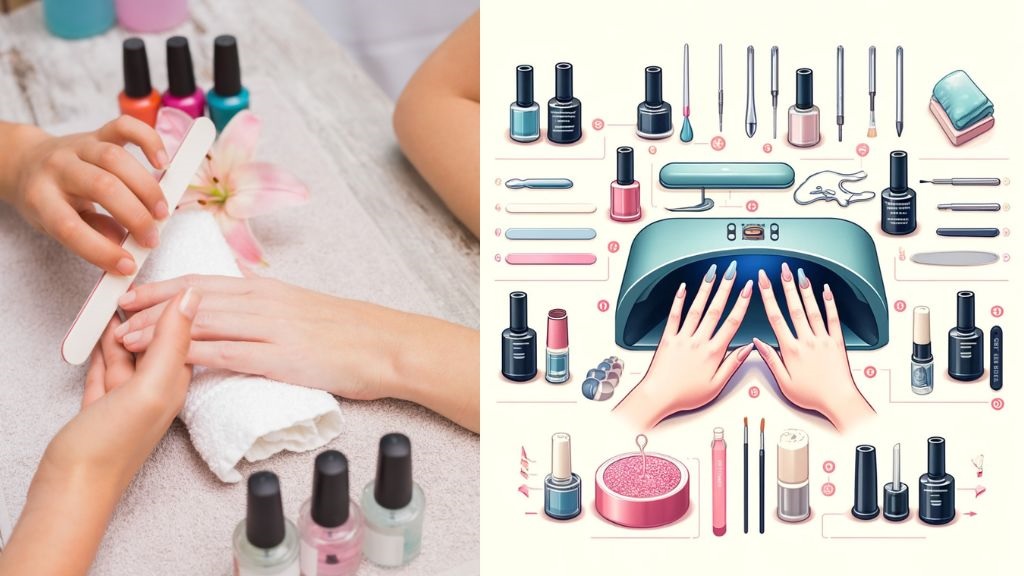
- Preparation: The nails are cleaned, and the nail beds are prepared by pushing back and trimming the cuticles. The nails are then shaped and buffed to create a smooth surface.
- Base Coat: A thin base coat is applied to the nails, which helps the gel polish adhere better and protects the nails from staining.
- Gel Polish Application: The gel polish is applied in thin layers. Each layer must be cured under a UV or LED lamp for 30 seconds to a few minutes to harden and set the polish.
- Curing: After each layer of gel polish is applied, the nails are placed under a UV or LED light. This process cures the polish, making it extremely durable and resistant to chipping.
- A top coat is applied last and cured under the lamp to seal in the color and add a glossy finish.
- Finishing Touches: After curing the top coat, any sticky residue is wiped off with a cleanser, and often, cuticle oil is applied to rehydrate the skin around the nails.
Gel manicures are popular because they provide a long-lasting, chip-resistant finish that can last up to two weeks or more with proper care. However, removal requires soaking the nails in acetone and can be more damaging to the nails than regular nail polish if not done carefully.
What is the healthiest nail option?
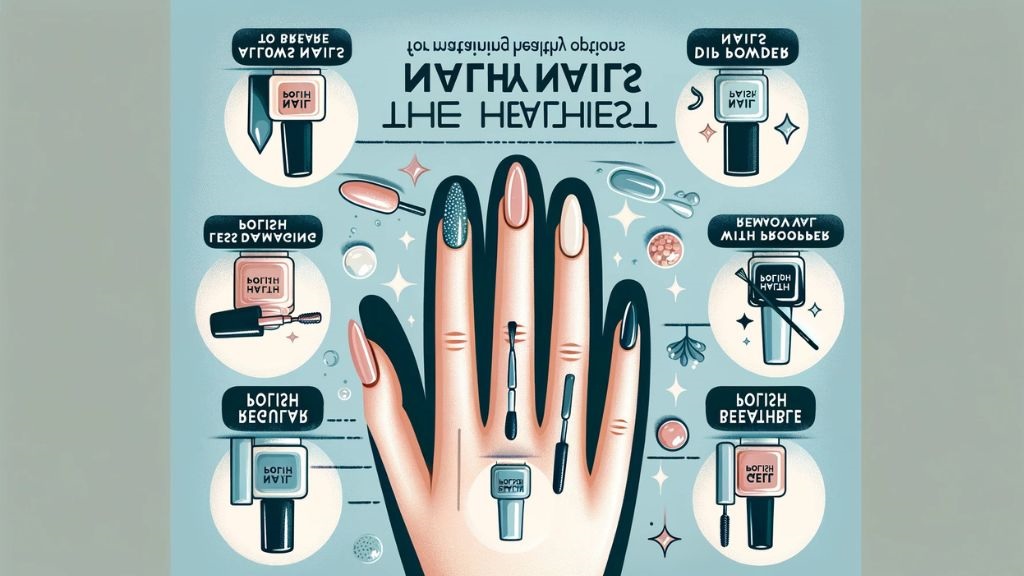
When it comes to maintaining healthy nails while still enjoying a polished look, several options are considered less damaging and healthier for your nails. Here’s a rundown of some of the healthiest nail options:
- Regular Nail Polish: Unlike gel or acrylic nails, regular nail polish doesn’t require UV light to cure, nor does it involve harsh removal processes. It’s easy to apply and remove at home using nail polish remover. Regular polish is a good option for those who like to change colors frequently without much damage to the nail beds.
- Nail Strengtheners: These are formulated to improve the health and strength of your nails. They contain vitamins, proteins, and other nutrients that can help reinforce nail structure, prevent splitting, and increase flexibility.
- Water-Based Nail Polish: This type of nail polish is free from the harsh chemicals typically found in traditional polishes, such as formaldehyde, toluene, and dibutyl phthalate. Water-based polishes are less drying to the nails and don’t emit strong odors.
- Breathable Nail Polish: These allow water and oxygen to pass through to the nail, which can be healthier for the nail bed than traditional polishes that seal off the nail completely. They are particularly popular among those who prefer to wear polish for prolonged periods or for religious reasons, as they are often halal certified.
- Dip Powder Nails (with Caution): While dip powders are similar to acrylics, they don’t require UV light for curing and can be a bit healthier for the nails if applied and removed properly. However, the dipping process can be hygienic if the powder is contaminated, so it’s important to ensure clean practices.
- Simply buffing your nails can give them a natural shine without any polish at all. This method involves no chemicals, but excessive buffing can thin the nails, so it should be done sparingly.
- Bi-weekly Manicures: Giving your nails a break between manicures can significantly improve their health. During these breaks, treating the nails and cuticles with oils and creams can help maintain moisture and repair damage.
Each of these options has its benefits and drawbacks, and the healthiest choice can depend on your nail type and personal preferences. Regardless of the method you choose, proper nail care—like keeping nails clean, moisturized, and trimmed—can help maintain your nail health.
How often is it safe to get gel manicure?
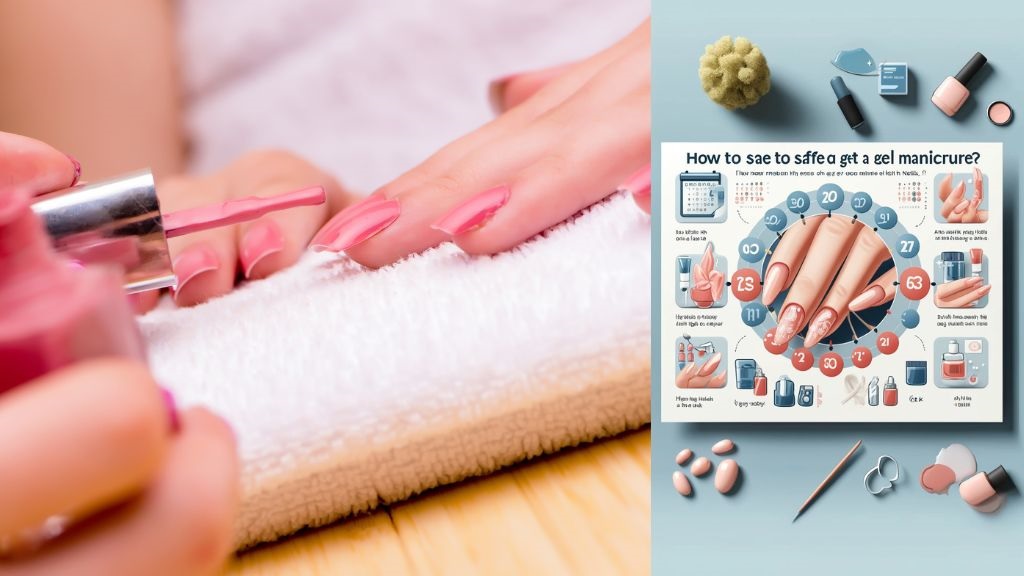
While gel manicures offer a long-lasting and glossy finish, frequent application can lead to some nail health issues. To maintain the health of your nails while enjoying the benefits of gel manicures, consider the following guidelines:
- Moderation in Frequency: Ideally, it’s safe to get a gel manicure once every three to four weeks. This schedule allows your nails some time to recover between applications. Giving your nails a break from any type of polish can also help prevent thinning and dehydration.
- Nail Health Monitoring: Pay attention to the condition of your nails. If you notice signs of damage, such as thinning, brittleness, or discoloration, it might be wise to extend the break between your gel applications. Use this time to treat your nails with nourishing oils or a strengthening treatment.
- Professional Application and Removal: Ensure that your gel manicures and removals are done by a professional. Incorrect application or removal can increase the risk of nail damage. Professionals know how to apply and remove gel polish in a way that minimizes harm to the nail bed.
- Protective Measures: Use a nail strengthener between manicures to reinforce your nails. Additionally, applying a cuticle oil daily can help keep your nails and surrounding skin hydrated and healthy.
- UV Protection: Since curing gel polish requires UV light, which can contribute to skin aging and the risk of skin cancer, consider applying a broad-spectrum sunscreen to your hands before placing them under a UV or LED lamp.
Following these guidelines can help you enjoy gel manicures more safely and keep your nails in good condition. If you love the look of gel but are concerned about the effects, you might also explore alternatives like bio-gel or soak-off gel, which are generally less damaging and easier to remove.
Read more: top 10 cute simple valentines pedicure & manicure ideas
How to repair damaged nails from gel?
If your nails have been damaged by frequent gel manicure applications, there are several steps you can take to help repair and restore them. Here’s a comprehensive approach to nursing your nails back to health:
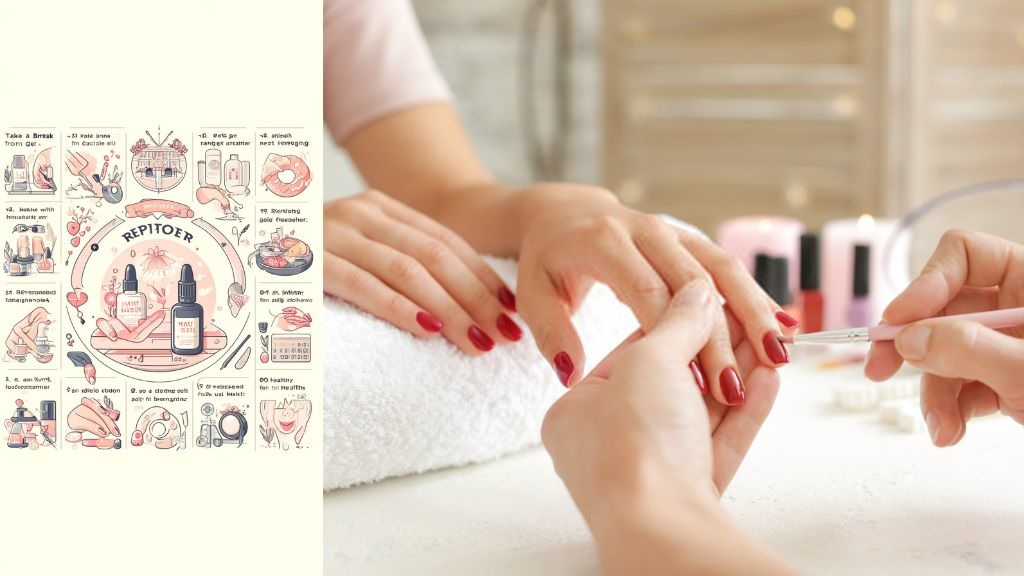
- Give Your Nails a Break: Allow your nails to rest and recover by taking a break from all types of nail polish, especially gel. This will prevent further stress on your nails and cuticles, allowing them time to repair naturally.
- Keep Nails Trimmed: Keep your nails shorter while they are damaged. Short nails are less likely to snag or break, which can exacerbate nail damage.
- Moisturize Your Nails and Cuticles: Nails and cuticles can become extremely dry and brittle after gel manicures, especially due to the acetone used in removal. Regularly apply a nourishing cuticle oil or cream to moisturize and strengthen the nail bed and cuticles. Products containing Vitamin E, jojoba oil, or shea butter are particularly effective.
- Use a Nail Strengthener: Consider using a nail strengthener that contains ingredients like keratin or biotin, which can help reinforce the nails and promote growth. Be sure to follow the product’s application instructions for the best results.
- Maintain a Healthy Diet: Nutrition plays a key role in nail health. Ensure your diet includes plenty of vitamins and minerals that support nail growth and strength. Foods rich in protein, Vitamin D, Vitamin B7 (biotin), zinc, and iron are particularly beneficial.
- Hydration: Stay hydrated by drinking plenty of water. Hydration is important for maintaining overall health, including the health of your nails.
- Avoid Harsh Chemicals: When doing household chores or using cleaning agents, wear gloves to protect your nails from harsh chemicals. This will prevent further drying and weakening of the nail structure.
- Gentle Nail Care: Avoid nail care tools and procedures that can cause damage, such as metal files or aggressive buffing. Use a gentle, fine-grit file to shape your nails and avoid scraping or digging under the nail plate.
Consult a Professional: If your nails are severely damaged or you’re concerned about their condition, consider consulting a dermatologist or a professional nail technician. They can provide tailored advice and treatments to help restore your nails’ health.
Is regular nail polish safer than gel?
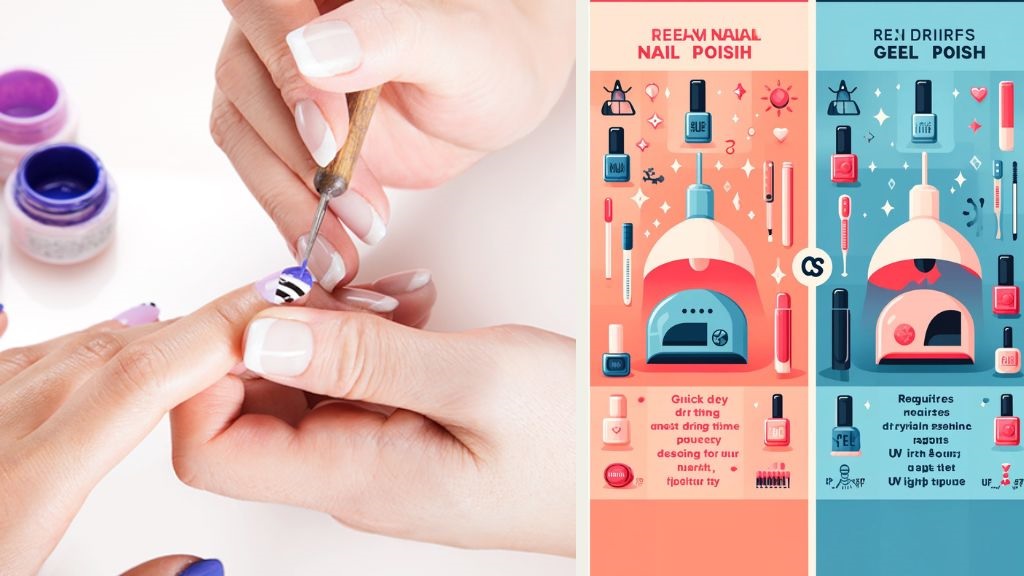
Yes, regular nail polish is generally considered safer than gel polish for a few reasons:
- Chemical Exposure: Regular nail polish typically contains fewer harsh chemicals compared to gel polish. While both types can contain substances like toluene, dibutyl phthalate (DBP), and formaldehyde, gel polishes also require additional chemicals that are part of the curing process. Many regular nail polishes are now formulated to be “3-free” (free from toluene, DBP, and formaldehyde) or even “5-free” and “7-free,” excluding more potentially harmful chemicals.
- UV Light Exposure: Gel polish requires curing under UV or LED light, which can expose the skin to UV radiation. Although the levels of UV radiation are low, repeated exposure can potentially increase the risk of skin aging and skin cancer. Regular nail polish does not require light curing, avoiding this risk altogether.
- Nail Damage and Removal: Gel polish is much more difficult to remove than regular nail polish. Removing gel polish typically involves soaking the nails in acetone and often scraping the polish off, which can be damaging to the nail bed and cuticles. Regular nail polish can be removed simply with a gentle nail polish remover without extensive soaking or aggressive scraping.
- Flexibility and Nail Health: Regular nail polish is less rigid than gel, which means it moves with the natural nail and is less likely to cause breaks or chips in the nail itself. The flexibility of regular polish can be more forgiving on the nails, especially for those who have brittle or weak nails.
- Hydration: Regular nail polish doesn’t typically cause as much dehydration to the nails as gel polish. The heavy-duty removal process for gel can significantly dry out nails and cuticles, whereas regular polish can be removed more gently.
Despite these advantages, regular nail polish does not last as long as gel polish and lacks the same glossy, durable finish. It also requires more frequent application, which could lead to more frequent exposure to the chemicals in the polish, albeit less harsh ones.
Ultimately, the choice between regular and gel polish should consider your lifestyle, preference for nail appearance, and concern for nail health. For the healthiest approach, regardless of polish type, it’s essential to give your nails breaks from polish, maintain good nail hygiene, and use nourishing treatments regularly.
Conclusion:
While gel nails can be a convenient and attractive option, they come with potential risks to your nail health. Being aware of these risks and taking preventive measures can help you maintain healthy, strong nails while still enjoying the benefits of a professional manicure.
In conclusion, gel nails, when properly applied and maintained, do not ruin your natural nails. The key to healthy and strong nails lies in seeking professional expertise, adhering to proper application and maintenance techniques, and ensuring safe removal methods. By following these guidelines, you can enjoy the benefits of gel nails while preserving the overall health and strength of your natural nails.
- #1 How to do DIY gel nails for beginners at home
- #1 Debunking the Myths: Do gel nails ruin your nails?
- [ The average ] How much do nail techs make a year?
- #1 When is national nail tech day | 2027
- Comprehensive guide are pedicures safe during pregnancy







 to have themselves prettified
to have themselves prettified
Add comment